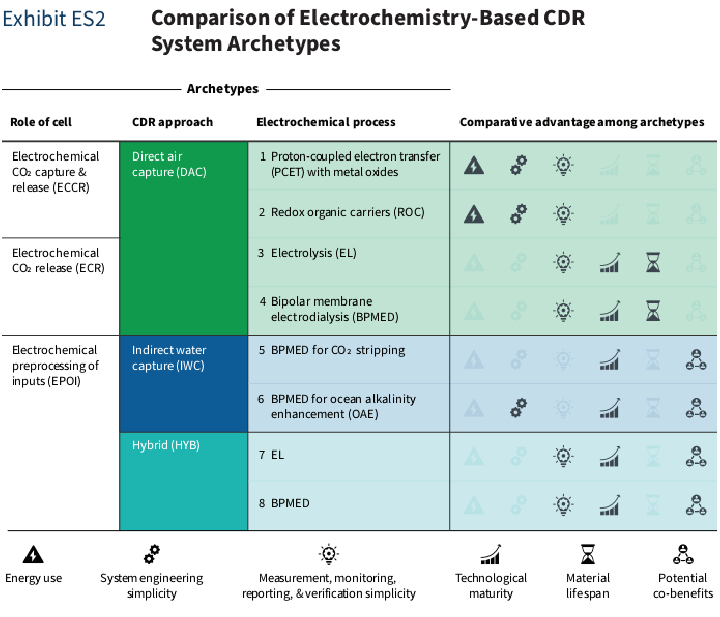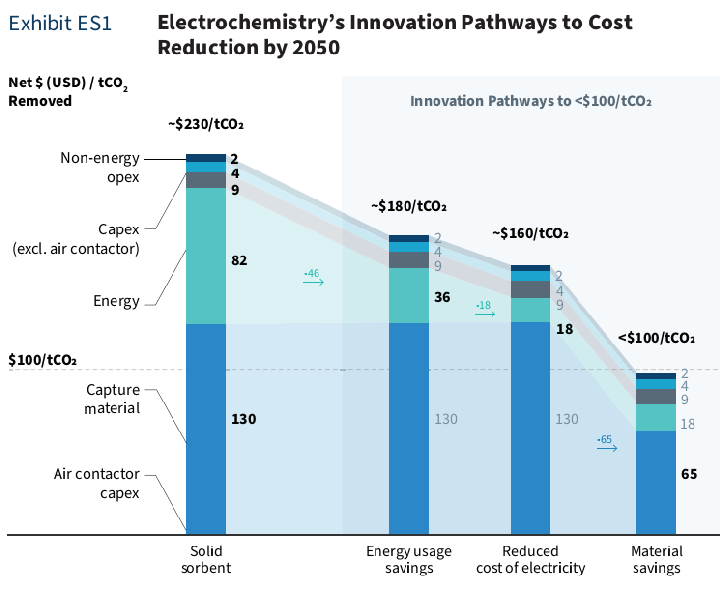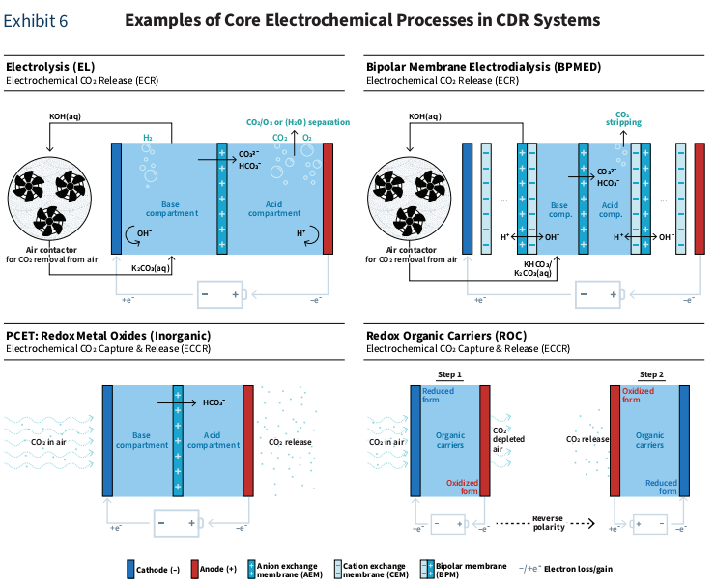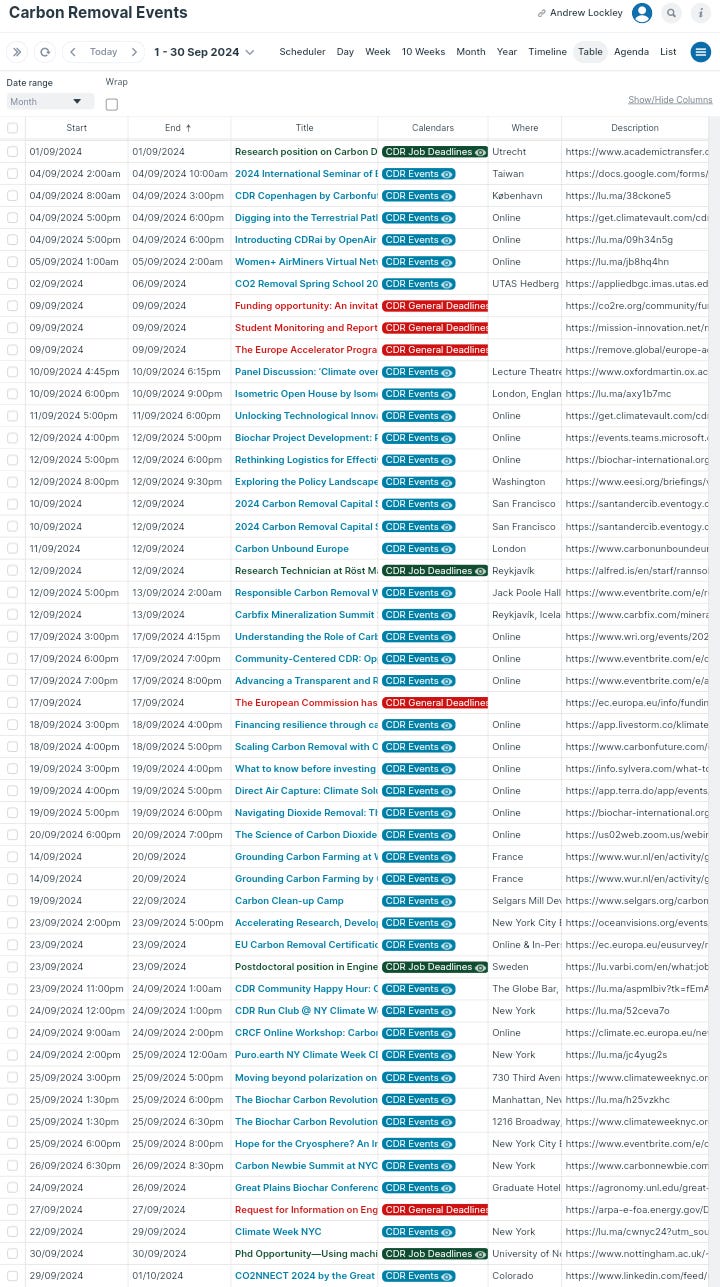CARBON REMOVAL WEEKLY SUMMARY (02 SEPTEMBER - 08 SEPTEMBER 2024)-WEEK#36
Links to recent scientific papers, web posts, upcoming events, job opportunities, podcasts, and event recordings, etc. on Carbon Dioxide Removal Technology.
📋TABLE OF CONTENTS
1. Commercial News
2. Research Papers
3. Web Posts
4. Thesis
5. Reports
6. CDR Film
7. Upcoming Events
8. Job Opportunities
9. Podcasts
10. YouTube Videos
11. Deadlines
Note: Click on the headings listed in the table of contents above to easily navigate to the sections you're interested in.
💸COMMERCIAL NEWS
Carbyon closed €15.3M Series A investment to demonstrate its fast-swing Direct Air Capture technology at full scale (Carbyon)
CarbonX closes new investment round to scale Carbon Dioxide Removal Portfolio Management (CarbonX)
Spiritus is offering to remove 100 tons of CO2 from Starbucks, CEO Brian Niccol’s September flights in exchange for 10,000 Pumpkin Spice Lattes (Spiritus)
Supercritical has partnered with Exomad Green to offer exclusive biochar carbon credits to corporate buyers (Supercritical)
Quadrature Climate Foundation has reached a new milestone – since inception, the foundation has committed over $1bn in climate-focused grantmaking, with 10% of its funding going towards scaling carbon removals (Quadrature Climate Foundation)
EPA issued draft Class VI permits for the 1PointFive Stratos DAC facility in West Texas to sequester CO2 emissions deep underground (The Verge)
Skytree has partnered with Finland-based manufacturing firm Scanfil for the development of its new DAC units in the US and Europe (Yahoo)
Mangrove System partnered with Pacific Biochar to launch the first biochar project on Climate Action Reserve (Mangrove Systems)
NeoCarbon has opened a chemical laboratory at its Berlin site to test out the use of its in-house sorbents, the fundamental material needed for direct air capture (The Chemical Engineer)
CarbonCaptureUS paused development of project Bison in Wyoming and is looking to relocate to another state due to high competition for renewable energy from rapidly growing data centers (E&E News)
CarbonxClimate announced a new collaboration with The Center for Negative Carbon Emissions at the Arizona State University as the two organisations work to strengthen the company’s review process of Carbon Removal suppliers (CarbonX Climate)
Greenlyte has been awarded public funding from the European Union and the federal state of NRW through the EFRE/JTF in NRW Grüne Gründungen Innovation competition to further develop our absorption and desorption units (LinkedIn)
A new climate project has launched in Cornwall from Restord, a local startup using a special method called biochar to trap carbon in the soil and improve soil health (Restord)
Montana Technologies, developer of AirJoule atmospheric water tech, has signed an MOU with Clairity Technology to deploy AirJoule units for Clairity's direct air capture carbon removal operations (Market Insider)
Blusky, a new player in carbon removal technology, announced its shares are now eligible for electronic clearing and settlement through the Depository Trust Company following its OTCQB Market listing (Blusky Carbon)
Isometric has recently been designated as a Leading Credit Issuer for Frontier, the advance market commitment that will buy $1 billion of carbon removal by 2030 (Isometric)
Carbon marketplace Nori is officially shutting down due to the challenges of a stagnant Voluntary Carbon Market and tough funding environment (Carbon Herald)
📝RESEARCH PAPERS
Techno-economic analysis of geothermal combined with direct and biomass-based carbon dioxide removal for high-temperature hydrothermal systems
Titus, K. A., Dempsey, D., Peer, R. A., & Archer, R. (2024). Techno-economic analysis of geothermal combined with direct and biomass-based carbon dioxide removal for high-temperature hydrothermal systems. Geothermics, 125, 103159.
Synopsis: This study evaluates the cost-effectiveness of coupling carbon capture and sequestration technologies, BECCS and DACCS, with geothermal power to enhance carbon dioxide removal. Findings show that geothermal-BECCS generates more electricity and lowers emissions abatement costs ($122/tCO2) compared to geothermal-DACCS ($187/tCO2). The study highlights geothermal-BECCS as a more cost-effective CDR strategy due to its increased electricity production and reduced decarbonization costs.
Seaweed farming environments do not always function as CO2 sink under synergistic influence of macroalgae and microorganisms
Xiong, T., Li, H., Hu, Y., Zhai, W. D., Zhang, Z., Liu, Y., ... & Zhang, Y. (2024). Seaweed farming environments do not always function as CO2 sink under synergistic influence of macroalgae and microorganisms. Agriculture, Ecosystems & Environment, 361, 108824.
Synopsis: This study investigates the dual role of seaweed farming in carbon sequestration, showing that kelp can act as both a carbon sink and source depending on its growth stage. During the fast-growth stage, kelp absorbs CO2, but at the aging stage, it becomes a CO2 source due to increased microbial respiration. The findings emphasize timely harvesting to maximize kelp's carbon sink function and environmental benefits, offering crucial insights for seaweed farm management.
Antarctic krill sequester similar amounts of carbon to key coastal blue carbon habitats
Cavan, E.L., Mackay, N., Hill, S.L. et al. (2024). Antarctic krill sequester similar amounts of carbon to key coastal blue carbon habitats. Nat Commun 15, 7842.
Synopsis: This study highlights the significant carbon sequestration role of Antarctic krill through their fast-sinking faecal pellets, which sequester 20 MtC per season—comparable to coastal blue carbon systems. With carbon stored for over 100 years, this represents $4-46 billion in carbon value. The findings underscore the need to protect krill populations, which are threatened by climate change and expanding fisheries, to preserve their critical carbon sink function.
Negative emission enabled by combining ocean alkalinity enhancement and waste concrete upcycling
Jin, S., Tyka, M., Martinez, C. R., Davis, C., Van Arsdale, C., & Papania-Davis, A. (2024). Negative emission enabled by combining ocean alkalinity enhancement and waste concrete upcycling.
Synopsis: This study explores a novel method to neutralize the acid byproduct of electrochemical ocean alkalinity enhancement (OAE) using recycled concrete aggregates (RCA). Findings show that RCA can effectively neutralize acid, reduce its concentration from 0.5M to 0.1M HCl, and produce high-quality construction materials. This method could achieve large-scale CO2 removal while recycling gigatons of construction waste, offering economic and environmental benefits.
Understanding the mechanisms and potential pathways of soil carbon sequestration from the biogeochemistry perspective
Feng, X., Dai, G., Liu, T., Jia, J., Zhu, E., Liu, C., ... & Li, W. (2024). Understanding the mechanisms and potential pathways of soil carbon sequestration from the biogeochemistry perspective. Science China Earth Sciences, 1-11.
Synopsis: This study reviews the mechanisms and processes of soil carbon sequestration as a vital tool for achieving carbon neutrality. It highlights plant inputs, microbial transformation, mineral protection, and rock weathering as key pathways for enhancing soil carbon storage. The findings emphasize using advanced biogeochemical methods to deepen understanding of soil carbon dynamics, supporting China’s efforts toward climate change mitigation and carbon neutrality goals.
Next steps for assessing ocean iron fertilization for marine carbon dioxide removal
Buesseler, K., Bianchi, D., Chai, F., Cullen, J. T., Estapa, M., Hawco, N., ... & Yoon, J. E. Next steps for assessing ocean iron fertilization for marine carbon dioxide removal. Frontiers in Climate, 6, 1430957.
Synopsis: This study assesses ocean iron fertilization (OIF) as a marine CO2 removal method, introducing the "centennial tonne" metric to quantify carbon storage over 100 years. Five key activities are proposed: field studies, modeling, improved monitoring, iron delivery methods, and public governance. OIF shows potential as a low-cost, scalable approach, but the study emphasizes the need for responsible research and public support before deployment.
Enhanced rock weathering: potential UK greenhouse gas removal
Forrest, N., & Wentworth, J. (2024). Enhanced rock weathering: potential UK greenhouse gas removal.
Synopsis: This study investigates Enhanced Rock Weathering (ERW) as a Greenhouse Gas Removal (GGR) strategy to help the UK achieve Net Zero emissions by 2050. ERW accelerates natural rock weathering to capture CO2, potentially removing 6-30 Mt CO2/year. However, challenges remain regarding the efficiency of CO2 removal, scaling up operations, and environmental impacts. ERW may also boost agricultural yields, offering dual climate and farming benefits.
Carbon-Oriented Energy System Planning Using Forest Carbon Sink
Liu, Y., Lu, Z., Zhang, J., Li, Y., Guo, X., & Li, X. (2024). Carbon-Oriented Energy System Planning Using Forest Carbon Sink. Energy, 133010.
Synopsis: This study develops a carbon-cycle integrated energy hub (CC-EH) model to explore the economic benefits of incorporating forest carbon sinks (FCSs) in zero-carbon energy system planning. Results from case studies in six Chinese cities show that FCSs can offset up to 55.31% of CO2 emissions and reduce planning costs by 36%. The model highlights the role of FCSs in helping cities meet their 2060 carbon-neutral goals.
Potential for carbon dioxide removal of carbon capture and storage on biomass-fired combined heat and power production
Weimann, G. G., & Bentsen, N. S. (2024). Potential for carbon dioxide removal of carbon capture and storage on biomass‐fired combined heat and power production. GCB Bioenergy, 16(9), e13184.
Synopsis: This study evaluates the carbon dynamics and emissions of Bioenergy with Carbon Capture and Storage (BECCS) at a Danish biomass-fired CHP plant. Results show GHG emissions from CCS processes are ~100 kgCO2/t stored CO2, with a carbon payback time of 3-4 years. Although only 90% of CO2 is captured, BECCS can store −742 kgCO2/t by year 99. The study highlights the need for better assessments of BECCS's role in climate mitigation.
Mapping the landscape of carbon dioxide removal research: a bibliometric analysis
Presty, R., Massol, O., Jagu, E., & da Costa, P. (2024). Mapping the landscape of carbon dioxide removal research: A bibliometric analysis. Environmental Research Letters.
Synopsis: This study analyzes 7,893 publications on carbon dioxide removal technologies from 2012-2023, using bibliometric methods. It reveals significant growth in research, particularly since 2018, driven by the EU, China, and the US. Key areas include biochar, afforestation, and soil carbon sequestration. The study proposes a roadmap to guide future research and policy development based on these trends.
Can coastal and marine carbon dioxide removal help to close the emissions gap? Scientific, legal, economic, and governance considerations
Johnson, M., van Doorn, E., Hilmi, N., Marandino, C., McDonald, N., Thomas, H., ... & Swarzenski, P. (2024). Can coastal and marine carbon dioxide removal help to close the emissions gap? Scientific, legal, economic, and governance considerations. Elem Sci Anth, 12(1), 00071.
Synopsis: To guide climate change mitigation, this Policy Bridge highlights the potential of coastal blue carbon and marine CDR to reduce CO2 emissions, especially post-2050. Findings stress the need for urgent governance frameworks to ensure safe, effective implementation. Enhanced research, monitoring, and co-creation of governance across sectors are crucial for managing risks and maximizing benefits of these systems in the 21st century.
Review Analysis on Scalability of Carbon Removal Methods and Regulatory Framework for Carbon Management for Companies that sell materials to remove CO2
Nayab, T., Ahmed, T., & Wijekoon, D. (2024). Review Analysis on Scalability of Carbon Removal Methods and Regulatory Framework for Carbon Management for Companies that sell materials to remove CO2. Journal of Applied Geoscience and Engineering, 3(1), 01-16.
Synopsis: This article reviews carbon capture technologies, including CARBiNX, forest-based capture, Direct Air Capture (DAC), and Carbfix. It finds that while these methods are promising, they vary in effectiveness, cost, and scalability. CARBiNX and DAC are innovative but costly, while forest-based capture offers lower costs with substantial potential. Geological storage, like Carbfix, is effective but requires further scaling. The study highlights the need for interdisciplinary collaboration and robust regulatory frameworks to advance these technologies for gigaton-scale CO2 removal.
Harnessing green tide Ulva biomass for carbon dioxide sequestration
Park, J., Lee, H., De Saeger, J., Depuydt, S., Asselman, J., Janssen, C., ... & Han, T. (2024). Harnessing green tide Ulva biomass for carbon dioxide sequestration. Reviews in Environmental Science and Bio/Technology, 1-21.
Synopsis: This review evaluates the repurposing of harmful Ulva seaweed blooms for carbon sequestration. By converting Ulva biomass into biochar through pyrolysis, the study reveals potential for sequestering 3.85 million tons of CO2 equivalent, with 1.93 million tons stabilized as biochar. This approach mitigates greenhouse gas emissions and improves soil quality. The techno-economic analysis suggests that Ulva cultivation and biochar production could be both sustainable and profitable, offering a solution to the climate impact of green tides.
Optimization and Tradeoff Analysis for Multiple Configurations of Bio-Energy with Carbon Capture and Storage Systems in Brazilian Sugarcane Ethanol Sector
Bunya, B., Sotomonte, C. A., Vitoriano Julio, A. A., Pereira, J. L. J., de Souza, T. A. Z., Francisco, M. B., & Coronado, C. J. (2024). Optimization and Tradeoff Analysis for Multiple Configurations of Bio-Energy with Carbon Capture and Storage Systems in Brazilian Sugarcane Ethanol Sector. Entropy, 26(8), 698.
Synopsis: This study optimizes Bio-Energy with Carbon Capture and Storage (BECCS) for Brazilian cogeneration plants to enhance net electrical energy and CO2 capture. Evaluating six configurations, the single regenerator setup achieved the highest CO2 capture (51.9%) but reduced plant efficiency by 14.9%. In contrast, the three-regenerator system had lower efficiency loss (7.41%) but captured less CO2 (36.3%). Higher CO2 capture rates could lead to greater emissions per kWh, suggesting that moderate capture rates are more effective for reducing overall greenhouse gases in sugarcane-based plants.
Predicting the effect of climate change and management on net carbon sequestration in the forest ecosystems of the European part of Russia with the complex of models
Shanin, V., Chumachenko, S., Frolov, P., Priputina, I., Tebenkova, D., & Kolycheva, A. (2024). Predicting the effect of climate change and management on net carbon sequestration in the forest ecosystems of the European part of Russia with the complex of models. Ecological Modelling, 496, 110835.
Synopsis: This study integrates multiple ecological models to estimate changes in net carbon sequestration in Russian forest ecosystems under climate change and various management strategies. Simulations revealed that carbon sequestration rates ranged from 0 to 1.45 t ha/year, with higher accumulation in richer, moist habitats. Both climate change and management interventions had significant effects, with long-term climate impacts comparable to management practices. The study highlights the need for detailed, region-specific modeling to guide sustainable forest management and carbon sequestration efforts.
Design of alkali metal oxide adsorbent for direct air capture: Identification of physicochemical adsorption and analysis of regeneration mechanism
Huang, L., Ma, J., Wang, F., Xu, G., & Zhao, H. (2024). Design of alkali metal oxide adsorbent for direct air capture: Identification of physicochemical adsorption and analysis of regeneration mechanism. Carbon Capture Science & Technology, 13, 100268.
Synopsis: This study investigates the performance of CaO/HcATP (CaO loaded on acid-modified attapulgite) as a direct air capture (DAC) adsorbent. The research identifies that chemisorption of amorphous CaO significantly enhances both the adsorption capacity (426.7 µmol/g) and rate (50.85%). Silanol groups on CaO/HcATP are crucial, with their concentration affecting adsorption and regeneration. After 30 cycles, silanol concentration drops but recovers with moisture exposure. The study highlights the potential of CaO/HcATP to reduce desorption energy, aiding in cost-effective DAC adsorbent design.
Carbon Sequestration Characteristics of Typical Sand-Fixing Plantations in the Shiyang River Basin of Northwest China
Ma, Q., Wang, X., Chen, F., Wei, L., Zhang, D., & Jin, H. (2024). Carbon Sequestration Characteristics of Typical Sand-Fixing Plantations in the Shiyang River Basin of Northwest China. Forests, 15(9), 1548.
Synopsis: This study assesses the carbon sequestration capacity of six sand-fixing shrub plantations in northwest China's arid deserts, including Haloxylon ammodendron and Tamarix ramosissima. Findings reveal that plant species significantly influences carbon storage, with older plantations and those using clay-sand barriers or enclosures showing higher sequestration. A 25-year-old Haloxylon ammodendron plantation stores three times more carbon than a 3-year-old one. Prioritizing these species and management practices can enhance carbon sequestration in arid afforestation efforts.
Dynamics of bio-based carbon dioxide removal in Germany
Wollnik, R., Borchers, M., Seibert, R., Abel, S., Herrmann, P., Elsasser, P., ... & Thrän, D. (2024). Dynamics of bio-based carbon dioxide removal in Germany. Scientific Reports, 14(1), 20395.
Synopsis: This study analyzes standardized factsheets on various bio-based CO2 removal concepts, including natural sink enhancement, bio-based building materials, and BECCS. It finds that natural sink enhancements have gradually increasing CO2 removal rates that may plateau or decline over decades, while forest measures ramp up slowly, and construction and bioenergy projects maintain constant rates during operation. Removal costs vary widely (€8 to €520 per ton CO2), indicating that more cost-effective methods should be prioritized. The findings underscore the need for comprehensive evaluation considering economic, resource, environmental, and social factors for effective implementation in Germany's climate strategy.
The impact of co-adsorbed water on energy consumption and CO2 productivity in direct air capture systems
Wang, Y., & Li, G. K. (2024). The impact of co-adsorbed water on energy consumption and CO2 productivity in direct air capture systems. Separation and Purification Technology, 129415.
Synopsis: This study explores how co-adsorbed water impacts the efficiency of direct air capture using solid amine sorbents. By examining a polyethylenimine-impregnated sorbent, it was found that co-adsorbed water enhances CO2 desorption by reducing CO2 partial pressure during regeneration, especially at lower temperatures. Optimal relative humidities for minimizing energy consumption were also identified. These insights are crucial for designing more efficient DAC processes and sorbents, ultimately aiding in achieving net-zero emissions with reduced energy use.
Mechanisms and advancements in microwave-enhanced CO2 mineralization of lightweight porous concrete
Yang, L., Liu, Z., Luo, S., Liu, S., Guan, X., & Mi, T. (2024). Mechanisms and advancements in microwave-enhanced CO2 mineralization of lightweight porous concrete. Journal of Building Engineering, 110624.
Synopsis: This study examines the effect of moisture content on the performance of solid waste-based lightweight porous concrete (RSFAC) under CO2 mineralization curing. Moisture levels of 10%, 20%, 30%, and 40% were tested with microwave heating pretreatment. Results show that microwave pretreatment significantly reduces processing time compared to conventional methods, with 30% moisture yielding optimal compressive strength (up to 2.32 MPa) and CO2 sequestration (11.61%). The study also identifies key mineralization products and pore size effects, highlighting improved RSFAC performance.
High-Resolution Variability of the Ocean Carbon Sink
Gregor, L., Shutler, J., & Gruber, N. (2024). High‐resolution variability of the ocean carbon sink. Global Biogeochemical Cycles, 38(8), e2024GB008127.
Synopsis: This study presents a novel method combining machine learning and target transformations to estimate surface ocean CO2 fugacity (fCO2) and sea-air CO2 fluxes (FCO2) at an 8-day, 0.25° × 0.25° resolution from 1982-2022. Compared to previous coarse-resolution products, this high-resolution data improves accuracy in coastal regions and captures 15% more variance in FCO2, revealing detailed subseasonal variability and short-lived regional events like Hurricane Maria's impact. This advancement enhances understanding of ocean carbon sink dynamics and processes.
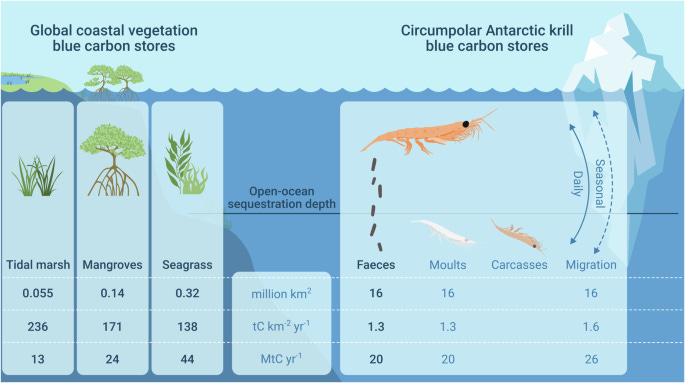
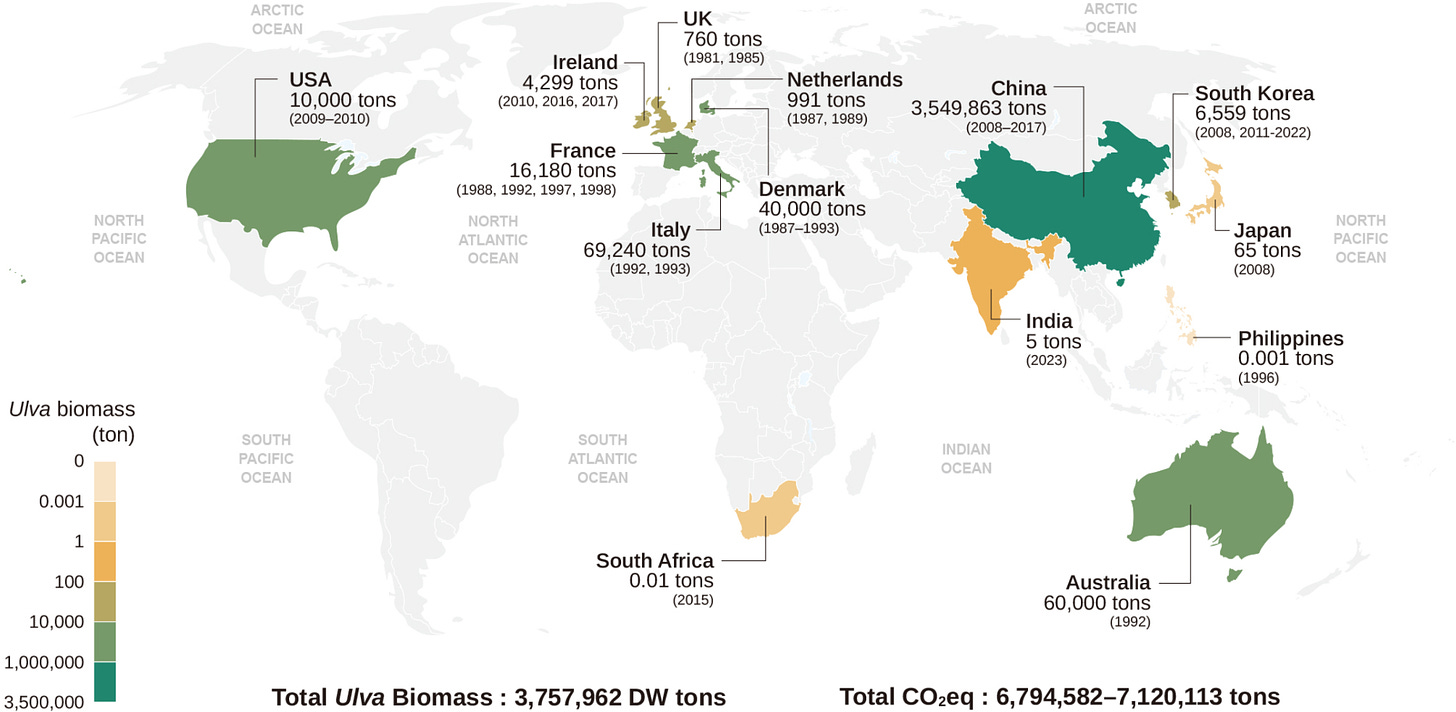
📰WEB POSTS
Up in the air (Filtration+Separation)
In theory, emission reduction credits are as good as removals (Milkywire)
What is carbon removal technology, and why can Canada be a global leader? (DeepDive)
Unveiling the fine-scale complexity of the ocean carbon sink (ETH Zurich)
Harness the Ocean’s Power: CDR technology (BGA News)
How U.S. And Canadian Government Direct Air Capture Incentives Compare (Forbes)
A climate expert’s return to Penn (Penn Today)
Doubling of carbon removal credit prices essential to sustain regenerative agriculture in US -study (Carbon Pulse)
How to solve the challenges faced by the carbon sequestration function of Chinese plantations in the future? (Eurekalert)
Growing solid carbon-negative subsurface marine foundations with electrolysis (Global Coral Reef Alliance)
Developer using AI to produce carbon removal technology open-sources model (Carbon Pulse)
Biochar doesn’t just store carbon – it stores water and boosts farmers’ drought resilience (The Conservation)
Cultivating local community trust in carbon removal (Illuminem)
How Amazon is helping to protect tropical rainforests as part of its efforts under The Climate Pledge (The Climate Pledge)
Japan adds CO2 to old-school debris to create stronger concrete bricks (Interesting Engineering)
Facebook parent Meta leaves carbon coalition (Axios)
A recent big tech plan for carbon removal is at the center of a major climate change emissions debate (CNBC)
AI boom to accelerate carbon removal, Morgan Stanley predicts (E&E News)
A sprinkle of crushed wollastonite helps crops and captures carbon, company says (CBC Lite)
Can weeds hold the key to turning farms into carbon storage powerhouses? (Corporate Knights)
Mind the [CDR] Gap (Climagination)
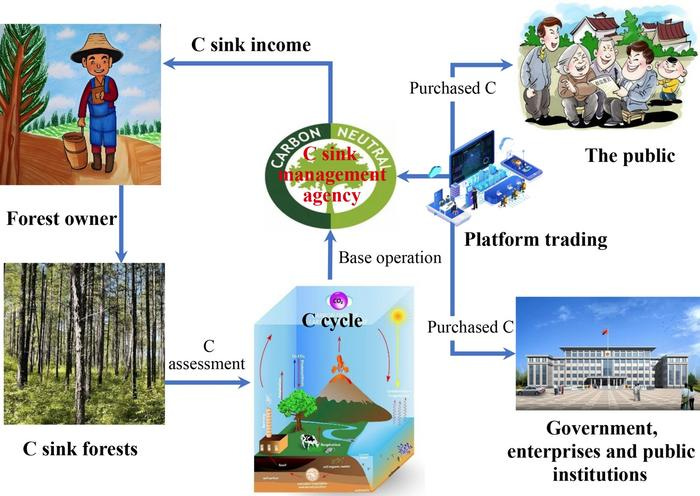
📖THESIS
Exploring the applicability of amine-containing metal-organic frameworks on direct air capture of carbon dioxide
📃REPORTS
Investing in Carbon Removal: Levers for the Private Sector
Breaking Barriers in Carbon Dioxide Removal with Electrochemistry
Clearing the Air: Trends in the Carbon Dioxide Removal Market
🎬CDR FILM
Legion 44 — The world’s first Carbon Removal Documentary — is coming this fall
🗓️UPCOMING EVENTS
Panel Discussion: ‘Climate overshoot: devastating risks and possible responses’ by University of Oxford | 10 September 2024 | Oxford, London
Isometric Open House by Isometric | 10 September 2024 | London, England
2024 Carbon Removal Capital Summit by XPRIZE & Santander CIB | 10-12 September 2024 | San Francisco
Unlocking Technological Innovation with Octavia Carbon by Climate Vault | 11 September 2024 | Online
Carbon Unbound Europe | 11-12 September 2024
Responsible Carbon Removal Workshop: Centering Indigenous Leadership by Carbon Removal Canada | 12 September 2024 | British Columbia
(NEW) Biochar Project Development: Risks & Solutions by Kita and GECA | 12 September 2024 | Online
Exploring the Policy Landscape of Carbon Dioxide Removal by The Environmental and Energy Study Institute (EESI) and the World Resources Institute (WRI) | 12 September 2024 | Washington
Rethinking Logistics for Effective Biochar Production by International Biochar Initiative | 12 September 2024 | Online
Carbfix Mineralization Summit 2024 | 12-13 September 2024
Grounding Carbon Farming at Wageningen University & Research by WIMEK in collaboration with SBL, ENP, NGO myclimate, and the farm "La ferme de Hyaumet" | 14-20 September 2024 | France
Community-Centered CDR: Opportunities and Challenges by Institute for Responsible Carbon Removal | 17 September 2024 | Online
Understanding the Role of Carbon Dioxide Removal in Long-term Climate Planning by World Resources Institute | 17 September 2024 | Online
Advancing a Transparent and Responsible mCDR Industry by Ocean Visions and Hourglass Climate | 17 September 2024 | Online
Scaling Carbon Removal with Confidence: The Key Role of Independent, Digital MRV by Carbonfuture | 18 September 2024 | Online
Financing resilience through carbon removal by Klimate.co | 18 September 2024 | Online
Roads to Removal, Options for Carbon Dioxide Removal in the United States | 18 September 2024 | Online & In-Person (Pennsylvania)
Navigating Dioxide Removal: The Role of Policy, Regulation, and Value Chains by International Biochar Initiative | 19 September 2024 | Online
What to know before investing in CDR—Navigating Challenges, Trends, and Future Opportunities by Sylvera | 19 September 2024 | Online
(NEW) Direct Air Capture: Climate Solution or Cover for Big Emitter | 19 September 2024 | Online
(NEW) The Science of Carbon Dioxide Removal: What Is It and Is It Needed? by California Environmental Voters | 20 September 2024 | Online
Carbon Clean-up Camp | 19-22 September 2024 | UK
Climate Week NYC | 22-29 September 2024 | New York
EU Carbon Removal Certification Framework: Rules on Verification and Registries - Stakeholder Workshop by EU Commission | 23 September 2024 | Online & In Person (Brussels)
CDR Community Happy Hour: Climate Week NYC Edition! by Carbon Business Council & 3 others | 23 September 2024 | New York
Accelerating Research, Development, and Demonstration for Responsible Marine Carbon Dioxide Removal – Where Are We on the Road to 2030? by Ocean Visions | 23 September 2024 | New York
(NEW) CDR Run Club @ NY Climate Week by Mangrove Systems | 24 September 2024 | New York
Puro.earth NY Climate Week CDR Summit by Puro.earth Americas | 24 September 2024 | New York
CRCF Online Workshop: Carbon Storage Certification of Buildings by EU | 24 September 2024 | Online
Great Plains Biochar Conference by The University of Nebraska–Lincoln Department of Agronomy and Horticulture, the Nebraska Forest Service and the Nebraska Biochar Initiative | 24-26 September 2024 | Nebraska
The Biochar Carbon Revolution: Innovative Financing, Products, and Partnerships to Reduce Value-Chain Emissions by International Biochar Initiative | 25 September 2024 | United States
Hope for the Cryosphere? An Introduction to Ocean Visions’ Road Map of Potential Approaches to Slow the Loss of Arctic Sea Ice by Ocean Visions | 25 September 2024 | New York
The Biochar Carbon Revolution by Grain Ecosystem | 25 September 2024 | Manhattan, New York
Moving beyond polarization on climate interventions at Climate Week New York | 25 September 2024 | United States
Carbon Newbie Summit at NYC Climate Week 2024 by BeZero, CEEZER, Clever Carbon | 26 September 2024 | New York
CO2NNECT 2024 by the Great Plains Institute's Carbon Action Alliance | 29 September - 01 October 2024 | Colorado
Bellona Climate Action Conference | 01 October 2024 | Brussels (Belgium)
(NEW) Carbon Reset Durable Carbon Removal Summit by Carbon Crew | 08 October 2024 | Mumbai
EO for Monitoring, Reporting, and Verification of Carbon Removals by European Environment Agency | 8-11 October 2024 | Copenhagen
Carbon Removal Canada's Policy Report Launch: Procuring with Purpose by Carbon Removal Canada | 09 October 2024 | Ottawa, Canada
Volcanoes and past climate: adventures with deep carbon | 12 October 2024 | Online & ExCeL London
The 2nd Swedish Conference on Sewage Sludge Biochar | 15-16 October 2024 | Sweden
IBI Biochar Study Tour: Italy by the Italian Biochar Association and the International Biochar Initiative | 16-18 October 2024 | Florence, Italy
Futures Summit 2024 by alt Carbon | 16-18 October 2024 | New Delhi
5th EU Carbon Removals Expert Group meeting | 21-23 October 2024 | Online
Exploring the Ethics and Societal Interactions of Climate Intervention by the U.S. National Science Foundation
Discovery workshop focussing on terrestrial science (CDR) | 22 October 2024 | Online
Discovery workshop focussing on ocean science (CDR) | 25 October 2024 | Online
Integrative synthesis workshop focusing on identifying gaps in current governance & ethics | 18 November 2024 | Online
Carbon Unbound West Coast | 24-25 October | San Francisco, USA
The State of Durable Carbon Removal by Verge | 29 October 2024 | California, US
Why Canada is poised to be a Carbon Removal Superpower by OSPE | 29 October 2024 | Windsor, ON
Carbon Removal Pathways We Don't Talk About Enough by Verge | 30 October 2024 | California, US
From Wetlands to the Deep Ocean: Dive Into Marine-Based Carbon Removal by Verge | 30 October 2024 | California, US
Getting to Gigatonne: Barriers (and Pathways) to Scaling Carbon Removal In The Next 25 Years by Verge | 30 October 2024 | California, US
How to apply biochar in sustainability management and accounting | German Biochar Forum | 18 November 2024
Industrial Energy Green Transition 2024 | 3-5 December 2024 | Tokyo
Scoping Workshop: Leaky deltas: sources or sinks in the global carbon cycle? by OCB | 17-20 March 2025 | Baton Rouge, LA
Bio-Char IV Conference | May 18-23, 2025 | Santa Marta, Colombia
We have curated a “Carbon Removal Events Calendar.” Explore and stay informed about upcoming events, conferences, and webinars on Carbon Dioxide Removal technology. Sync specific events / all events to your default calendar to ensure you never miss out on important CDR updates.
GUIDELINES:
Sync selected events to your default calendar in these simple steps:
1) Click on the event you want to sync.
2) Tap the menu icon (three vertical lines) at the top left.
3) Choose 'Share.'
4) Pick your default calendar.
5) Save the event.
Sync the entire Teamup Calendar to your default calendar with these simple steps:
1) Tap the menu icon (three vertical lines) at the top right.
2) Choose 'Preferences.'
3) Click 'iCalendar Feeds.'
4) Copy the URL shown for 'CDR Events / CDR General Guidelines / CDR Job Deadlines.'’
5) Paste the URL into your default calendar settings.
6) Click 'Subscribe' or 'Add Calendar.'
For more detailed instructions, visit: https://calendar.teamup.com/kb/subscribe-to-teamup-icalendar-feeds/
You can directly sync all Carbon Removal events to your default calendars by pressing the link below:
💼JOB OPPORTUNITIES
Research Technician at Röst Marine Research Center | Reykjavík | Deadline: 12 September 2024
"Röst Marine Research Center is a non-profit research organization that was founded as part of an international network of research centers under the Carbon to Sea Initiative. Carbon to Sea is an American non-profit organization that operates with the support of philanthropic organizations and science foundations in the field of climate. Röst Marine Research Center , in collaboration with the Carbon to Sea Initiative , intends to carry out research on the increased alkalinity of the sea (e.g. Ocean Alkalinity Enhancement)."
Back End Developer at Mati Carbon | New Delhi, India
"Mati Carbon PBC is at the forefront of climate-tech innovation, leveraging Enhanced Rock Weathering (ERW) to remove carbon from the atmosphere while boosting the livelihoods of smallholder farmers in the Global South. We are a US Public benefit corporation with operations in USA, India and Africa. We're on a mission to scale up our impact and need a talented Backend Developer to help us achieve our goals."
Senior Process Engineer at Paebbl | Rotterdam, The Netherlands
"Paebble's mission is to permanently sequester CO2 and repurpose it into essential products. Inspired by natural CO2 mineralization, our technology accelerates this process by a factor of a million and is now ready for scale-up. We are backed by supportive, long-term oriented institutional and private investors, and our team features a diverse group of experts from technology, industrial engineering, digital innovation, waste management, finance, and academia."
Head of People & Culture at Carbonfuture | Zurich
"Carbonfuture is the Trust Infrastructure for durable carbon removal. Today, the Trust Infrastructure consists of two products that seamlessly connect the entire carbon removal lifecycle: Carbonfuture MRV+, the most comprehensive MRV solution for durable CDR, and Carbonfuture Marketplace, the leading marketplace for durable CDR. At Carbonfuture, we build trust throughout the carbon removal journey with our rigorous, data-driven approach, ensuring unmatched quality and reliability of carbon removal. We empower suppliers by providing the essential project support and finance needed to transform their carbon removal projects into fully certified carbon credits. For corporate buyers, we offer access to portfolios of carbon removal credits adhering to the highest quality standards and provide visibility at each step of the carbon removal lifecycle via data-driven transparency enabled by Carbonfuture MRV+. We work with some of the world's most ambitious climate leaders such as Microsoft, Swiss Re, and the World Economic Forum First Movers Coalition."
Assistant Specialist in Biomass and Bioenergy at University of California | Riverside County, California | Deadline to apply: 03 October 2024
"The Assistant Specialist will work under the guidance of the Principal Investigator and the Co-Principal Investigator. The Assistant Specialist will conduct geospatial, lifecycle, and techno-economic research on biomass, biofuels and other bioproducts, and will be involved in researching products utilizing forest-sourced biomass to showcase at the demonstration sites and provide technical assistance to companies. The work will involve conducting literature reviews, gathering and analyzing data through market research, conducting techno-economic assessment (TEA), lifecycle assessment (LCA), and geospatial analysis, drafting reports/papers, and potentially preparing grant applications. The work will require developing and maintaining close collaborations with stakeholders including the state and federal agencies, industry, research institutions, non-governmental organizations (NGOs), forest landowners and the public."
Senior Carbon Removal Verification Engineer / Scientist at 350Solutions | North Carolina, United States
"350Solutions is a consulting group that provides independent evaluation of new environmental and cleantech innovations and independent verification of carbon removal and utilization projects and credits."
Electrolyzer Design Engineer at Equatic | Los Angeles, California
"Equatic addresses one of mankind’s most pressing problems, climate change, by removing carbon dioxide (CO2) from the atmosphere, while co-producing hydrogen (H2) as a green fuel, both at very low cost. This is based on a novel process that allows electrolyzing sea water, and which stabilizes CO2 permanently in the form of dissolved bicarbonate ions (in seawater), and solid mineral carbonates. Equatic recently announced the construction of the world’s largest marine carbon dioxide removal facility in Singapore, with a CO2 removal capacity of ~3.5 kilotonnes CO2 per year, as well as engineering & design for a commercial plant in Canada with the capacity to remove 100 kilotonnes CO2 per year. Equatic has offtake contracts in place over up to 80 kilotonnes of CO2 removal credits and H2 production to fill the capacity of these plants."
Various opportunities at Greenlyte:
"Greenlyte has developed a low energy, low capex process for the capture and utilization of CO2 from ambient air. In addition, H2 is obtained for subsequent conversion of CO2 and H2 to hydrocarbons increasing the technology’s profitability. It is a fully cyclic approach, i.e. the used absorbent is regenerated in the electrolysis and then reused for absorption."
Director of Information Technology at Graphyte | United States
"Combining photosynthesis with practical engineering, Graphyte’s Carbon Casting technology provides an immediate pathway for billions of tons of low-cost, durable carbon removal. With levelized production costs at under $100/ton with minimal energy requirements, we can remove CO2 for 1,000+ years."
Research Associate in Numerical Modelling for Direct Air Capture (DAC) Technologies at Heriot Watt University | Edinburgh, Midlothian, United Kingdom
"We are seeking a creative and motivated post-doctoral researcher to work as part of our international and multidisciplinary USorb-DAC (“Unlocking the scalable potential of sorbent-based DAC technologies”) team and with expertise to support our research activities in the project. The project’s aim is to discover adsorbents that can drastically reduce DAC’s energy intensity and cost so that DAC can scale rapidly and contribute to fighting climate change. By coupling basic science with engineering and environmental aspects, the team will develop an in-depth understanding of materials structure-property-performance relationships across different time scales and under relevant and realistic DAC operation conditions.
To achieve this goal, USorb-DAC unites the efforts of world-leading research teams from Heriot-Watt University, École Polytechnique Fédérale de Lausanne and Eidgenössische Technische Hochschule Zurich in Switzerland, University of California Berkeley in the USA, and the Centre National de la Recherche Scientifique (CNRS) in France."
Software Product Manager at Heirloom | Brisbane, California, United States
"Heirloom is mitigating the worst impacts of climate change by developing the world’s most cost-effective DAC technology to permanently remove CO2 from the atmosphere."
Carbon Removal Scientist, Biomass Feedstock Accounting at Isometric | London, New York
"Isometric is a carbon removal registry. We issue the world’s most scientifically rigorous carbon credits to help Fortune 100 companies tackle climate change and prevent greenwashing."
Senior Mechanical Engineer at Everest Carbon | Linz, Austria
"Everest Carbon is a fast-growing climate technology startup specializing in innovative sensor technology for the commercialization of negative emissions."
Planning and Scheduling Manager - Carbon Removals at Drax | Houston, TX, United States of America
"As the Planning & Scheduling Manager, you’ll be responsible for managing the effective implementation of Planning and Scheduling Best Practices across the execution of large scale, complex projects from Pre-FEED study development through to the commissioning of the facility for Global BECCS.
Additionally, as the Planning and Scheduling Manager you’ll be responsible for managing schedule, budget, and project control documentation for Global BECCS. Projects can include both greenfield and brownfield scope and may be in excess of $250MM in value."
Engineering Director - Carbon Removals at Drax Group | Houston, TX, USA
"As the Engineering Director, you’ll report to the VP, Project Management and you’ll be working closely with the Permit Director, Project Management Director and Execution team on technical aspects of development of multiple sites opportunities."
Operations Engineer Carbon Negative Materials at Co-reactive | Aachen, North Rhine-Westphalia, Germany
"At Co-reactive, we are developing innovative reactors that permanently capture CO2 as a solid, preventing it from entering the atmosphere. Whether it's stopping emissions from industrial processes or filtering CO2 directly from the air, we’re making a difference. The material from our process is a fine powder with enhancing properties in cement and concrete applications. We are pushing towards not only being a carbon sink technology but supplying long-needed carbon-efficient materials to the construction industry."
🎙️PODCASTS
Project finance for carbon removals | Climate Tech 360
"In this conversation, Martin Kessler, Chief Business Officer at Flowcarbon, discusses the company's role in securing asset-level financing for carbon removal projects. He explains that Flowcarbon is a vertically integrated carbon finance company focused on arranging project finance for carbon removal projects, assisting project developers with carbon credit issuance, and helping buyers procure carbon credits for their net zero goals. Martin emphasizes the interdisciplinary nature of the carbon markets and the importance of building a strong ecosystem of partners. He also provides insights into the project finance process and highlights the key factors Flowcarbon considers when evaluating projects, such as feedstock availability, revenue streams, and commercial viability. The company aims to demonstrate the viability of carbon removal projects to the private market community. Private credit investors typically get involved in the financing process once the project is at a stage where it is financeable. Flowcarbon helps developers develop financial models, create data rooms of financeable contracts, and secure necessary insurance. They also explore new market opportunities, such as environmental commodities markets and tax credits."
Are carbon removals on track for net zero | The Jolt
"In today’s episode of The Jolt, Kira looks at the development of carbon removal methods, plus United States presidential candidate Kamala Harris has a climate conundrum."
Captura’s Steve Oldham: “Removing a drop of ink from a swimming pool” | Danny in the Valley
"The Sunday Times’ tech correspondent Danny Fortson brings on Steve Oldham of Captura, to talk about why sucking CO2 out of the air is not a bad idea (6:30), using the ocean (10:00), their contraption (11:15), whether it can be done at scale (16:45), the maths of climate solutions (19:00), paying for it (21:00), the evolution of carbon removal tech (26:00), moving to Canada from England (30:00), how the space industry is like climate (31:45), the role of regulation (34:15), raising $60m (37:45), and politics (41:30)."
"We need to take CO2 out of the sky NOW," Dr. Gabrielle Walker, CUR8 co-founder | Carbonsations
"For this episode, we are joined by the co-founder of carbon removal procurement platform CUR8, Dr Gabrielle Walker. Dr. Walker shared with us her invaluable experience in the carbon removal industry, and discussed issues of supply & demand, the interest in carbon removals within the aviation industry, as well as what goes into putting together a carbon removal portfolio.”
Lukas May on carbon markets, the role of registries and developments in regulation | Grip
"Lukas May spoke about his work at Isometric, shared his insight on carbon markets and explained how firms can reach net zero."
🎥YOUTUBE VIDEOS
MADE IN KENYA | How Octavia, a local venture is using technology to remove CO2 from the atmosphere | Citizen TV Kenya
"We need to take CO2 out of the sky NOW," Dr. Gabrielle Walker, CUR8 co-founder | Carbon Herald
"For this episode, we are joined by the co-founder of carbon removal procurement platform CUR8, Dr. Gabrielle Walker. Dr. Walker shared with us her invaluable experience in the carbon removal industry, and discussed issues of supply & demand, the interest in carbon removals within the aviation industry, as well as what goes into putting together a carbon removal portfolio."
Roadmap to get DOE funding for your DAC startup | Tito - AirMiners
Green Carbon Webinar - Biochar Social Enterprise in Malaysia: Challenges and Lessons Learned | Green Carbon Webinar Series
Weekly Carbon Removal Updates from 02 September - 08 September 2024 | Carbon Removal Updates Bulletin
🚨DEADLINES
The European Commission has announced a $30 million (€28.5 million) call for proposals to provide funding for carbon dioxide removal projects in the EU | Deadline: 17 September 2024
(NEW) Request for Information on Engineering Solutions to Harvest Biomass Carbon for Durable Removal and Storage (Carbon Harvesting) | Deadline to respond: 27 September 2024
Call for Papers: EJRR Special Issue on Climate Interventions Governance (Carbon Dioxide Removal, Solar Radiation Modification, Regional Intervention)
Abstract Submission Deadline: 01 October 2024
Full Manuscript Submission Deadline: 31 December 2024




